SEO is a workflow and strategy that will drive organic, unpaid user traffic to your website.
SEO for Lawyers
Search Engine Optimization (SEO) For Lawyers And Attorneys
Search engine optimization is a website strategy that will help promote your website organically on search engines. The term organic in SEO means that you do not have to pay for advertisements to display on search results. SEO will make your website more visible to customers who are searching for your services online. SEO is all about online presence and providing authoritative and valuable content.
Here are the top three question our firm covers during a legal SEO consultation:
- Why does my law firm need an SEO strategy?
- Will search engine optimization work for my law firm?
- How long will SEO take before I see results?
This blog post will cover what SEO for law firms entails, how long it can take to see results, how people searching for your services land on your website, why you need SEO to grow your law firm’s digital presence, and tips and tricks to boost local SEO.
What Is SEO For Lawyers?
To understand SEO for lawyers, we will dive into the following topics:
- Your website’s design, speed and navigation, and mobile-friendliness
- Website content as an authoritative source
- How people land on your website
- What your competitors are doing for attorney SEO
- On-page SEO
- Technical SEO
- Off-page SEO outreach
- Local SEO
What it looks like when law firms optimize their SEO strategy:
- The firm’s website is packed with helpful and free information.
- Website designs are pleasing to the eye, and the site is easy to navigate.
- The law firm has implemented an SEO strategy and tracked the progress month after month.
- The law firm has worked hard on its local SEO strategy and generated client positive reviews.
- Local citations across Avvo, Yelp, Google, etc are consistent and standardized.
How Website Design Influences Law Firm SEO
Website design
Websites come in all shapes, colors, and sizes. Two traits of all great sites are aesthetically pleasing designs and a seamless user experience. If the user clicks on a site and it doesn’t load quickly or isn’t visually appealing, they will leave. Your firm could have lost a promising lead because the client had a bad experience with your site.
Mobile-friendliness
When your website loads on a mobile phone or tablet, does it look and feel similar to the desktop version? Your site will always look a little bit different on a phone or tablet, but images and text should scale down and look normal on the device. A website that scales to the device is called “mobile responsive.” Google prioritizes mobile website experience as an SEO ranking factor. You should definitely load your site on a mobile device to make sure everything looks in order.

Website speed and navigation
Ensure that your website is fast and easy to navigate. One great strategy for SEO success is internal linking, which is key for easy navigation. You can create internal links by using a drop-down menu, creating clickable buttons or icons, or linking directly from your content. SEO experts are always trying to find easy and intuitive ways to point the user in the right direction. Keep internal linking in mind when designing your website!
How Do Potential Clients Land On Your Website?
Search engine optimization is a strategy, a workflow, and even an art form. The goal of every Metrix Digital SEO campaign is to bring those searchers to you. So, why aren’t people visiting my site? Simply creating a website won’t get people in the door. If there are 50 other law firms in your city, how can you make sure that you are seen by potential clients? This is where SEO comes in!
Authoritative content
The number one activity that highly successful SEO agencies do for their legal clients is post meaningful content. When someone has a legal issue, they want to help and they want it now. It’s 9:30 at night, and they are browsing law firm after law firm looking for answers to their legal dilemma. The best course of action would be to call the law office and schedule a consultation. But, they can’t do that right now because it’s 9:30 at night.
So what can you do for them? If you are a criminal defense lawyer, you can post blogs about the services you provide. You should write about your firm’s specialty and how you can help clients. Don’t post boilerplate information just to add a page to your website. The best content is captivating and keeps the user on the page. You want to write blog posts that inform the user or put their mind at ease.
Put yourself in the client’s shoes. Is your website a place where the client can spend time and walk away more informed? If you write blogs with this goal in mind, I bet that that person will visit your site again the next morning and schedule a consultation.
How Google rewards great content
I want to relate the previous section about content to Google and the search engine. Session duration, bounce rate, and unique page views are important metrics to track and keep in mind.
Session duration is the time that a person spends on your site. If your content is well written and helpful, users will stick around on your site. They may even share your site with a friend.
Bounce rate is a metric that is logged when a user only visits a single page on your website and then leaves. If a user lands on your home page and does not visit any other pages before leaving, this is logged as a bounce. Though Google has stated that bounce rate is not a ranking factor, I do think this metric can be very valuable for website SEO optimization.
Session duration and bounce rate go hand-in-hand. As an SEO agency, our goal is to increase session duration and lower bounce rates.
What is my competition doing for SEO?
Law firms and the legal service industry are highly competitive spaces. The first step you should take before getting started with an SEO strategy is to spend some time reviewing the competition in your area. You can do this by putting yourself in the client’s shoes. Start searching for legal help online and review competitor websites.
If you are an immigration lawyer, search for services related to legal immigration help. If you are a local law firm, make sure to use keywords like “immigration lawyer near me” or “personal injury lawyer Houston.” The goal is to assess how the search engine is reacting to the average everyday query.
Now that you have a feel for the proper keyword terms a client might use to find you, start exploring the competition. I am stressing this to you because this is exactly what our firm will do when we start an SEO campaign for a client.
Are local competitors posting blogs four times per month or twice a week? Are the sites on the first page of Google designed in a certain way? All of these details matter to Google and the potential lead. How the person interacts with your site is being tracked by the search engine. Did they click on your site, like what they see, and decide to browse around? Or, did they land on your website and immediately leave (remember bounce)? Getting to know the competition and their site design will give you key insights into what you should be doing to continue building the firm and the business.
Lawyers are extremely busy people. You have spent years studying and honing your craft. That is precisely why I wanted to write this blog. I am a computer geek and proud of it. It’s my job to help you to navigate through the highly technical world of Google and search engine optimization. So, let’s dive into the technical world of SEO.
On-page SEO
To get started with law firm SEO, you need a live website that has been optimized for search engines like Google, Yahoo, or Bing.
Here are a few technical SEO terms that when optimized will help boost your search engine visibility:
- Target Keywords
- Title Tags
- Meta description
- Heading tags
- Internal Linking (We already discussed this topic, but it’s really important!)
Target keywords
Every page on your website should be accompanied by a keyword research project. If you didn’t already know, keyword research is a big deal. I am even doing keyword research as I write this blog! The goal when conducting keyword research is to find search phrases people are most likely to use.
Let’s take a look at the keyword “immigration lawyer houston” and see how many people are searching for that term on Google.
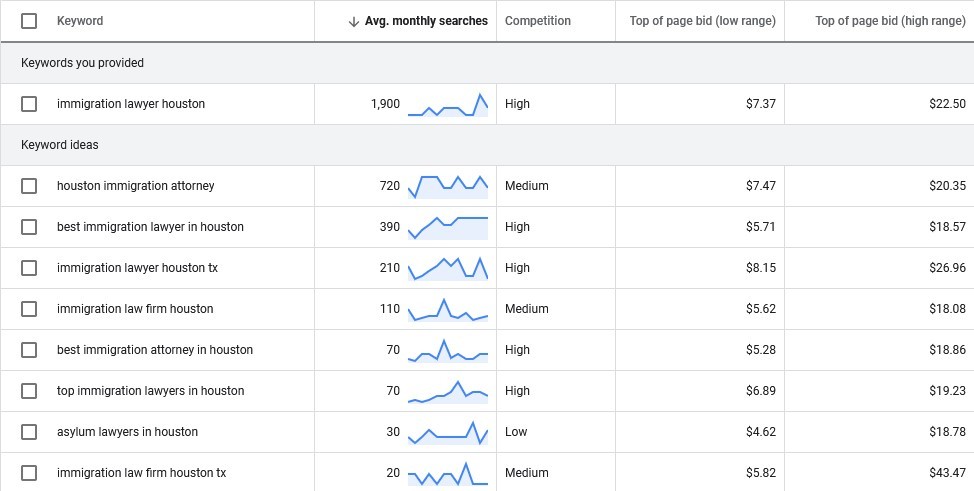
“Immigration lawyer houston” has an average monthly search volume of 1,900 queries. But, “immigration law firm houston tx” only has 20! These search terms are such close approximations, but one is clearly the winner. So, I hope you are asking yourself right now, “Are there any opportunities to optimize my site for better keywords?” Every service page on your website will have a variety of high-volume and low-volume keywords. Why not use language that includes the most frequently searched terms on Google? I believe that SEO success starts with keyword research and stellar content.
Title tags
Title tags are defined in the code of your website for every page. The SEO title tag is a description of the page. The SEO title tag is what the user sees and clicks on in the search engine results page (SERP). You want to make sure that the title tag is branded and descriptive. A branded title tag will showcase your business name and will be followed by the page’s title. Here is an example of Metrix Digital’s title tag for our homepage. We like to brand the title tag by using the Company Name | Description format. Our friends over at Moz have a great tool to see what your title tag would look like in Google.

Meta descriptions
Although meta descriptions are not part of the Google ranking algorithm, they can heavily influence a user’s choice to click on your site during a search. A meta description is around 160 characters in length. It is a descriptive caption that tells the searcher what your web page is about. Your law firm’s website should have an elegant meta description for each page. The meta description is similar to the title tag, but there are more words in the meta description.

Header tags
A header tag is a tiny bit of HTML code that tells the search engine what each section of your page is about. There are tags H1 through H6. These tags are placed in the content section of your webpage. The H1 tag is reserved for the page’s main title. H2 through H6 is used for subheadings. H2 is the next strongest heading and so on down the line to H6. The key takeaway is that logically using header tags to highlight the most important sections of your page.
Technical SEO
Be warned – technical SEO is somewhat of a dry topic. That being said, it is a major component of a fine-tuned law firm website. SEO experts always look at technical search engine optimization for potential problems with the website.
The major components (although not all of them) of technical SEO are as follows:
- What is your website speed rating?
- Can search engines crawl the page?
- Are internal links broken?
- Is the site protected with SSL security?
- Do you have pages talking about the same things (duplicate content)?
- Do you have an XML site map?
Site speed testing
Site speed can be measured using various online applications. We like to use GTmetrix and Google’s Page Speed Insights. Speed testing websites will give you valuable information regarding your website’s performance.
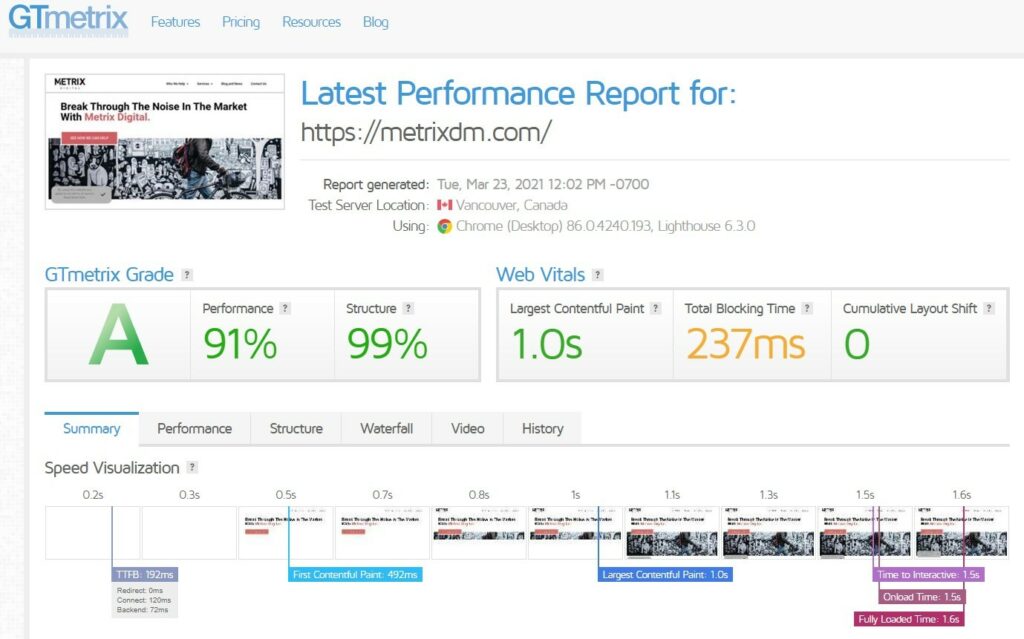
Every SEO campaign should look into methods to boost site speeds if website speed is an issue. Google has stated that site performance is now a ranking factor. That means your competitor’s website could rank higher on Google search if their site is performing better than yours.
The three core web vitals are largest contentful paint, cumulative layout shit, and first input delay. That means your site loads fast, users can interact with the website quickly, and the page doesn’t move around or shift while loading up.
Search engine crawlability
Your website must be set up to allow search engines to crawl and index your law firm’s page. When developing a new site, it is a common practice to turn this functionality off. However, you must allow search engines to crawl and index your site once the site goes live.
Check internal links for SEO errors
Internal linking helps direct search engines from page to page. It is important to help both clients and search engines move about your website with well-placed links.
Also, check to see if any URL links are broken. For example, let’s say you have an icon set that links over to a service page. But, you made a mistake and misspelled the URL when setting up your internal link. This will throw an error when the search engine or a potential client tries to follow that link. This could be enough of an annoyance that the client leaves your firm’s site altogether. Search engine optimization is all about these small details. They may seem irrelevant, but other lawyers in your area are doing everything they can to gain more and more market share.
SSL security
SSL security is a technology that encrypts the user’s connection to your website. SSL certificates are a must-have for your website. Having one will absolutely boost website traffic! Google has started notifying users if a site is not secured with an SSL certificate before they enter.
If you are not sure if your website is encrypted with SSL, check the URL. Encrypted URLs start with https://. Unsecured website URLs will only show http://. You can also check to see if the site is secure by looking for the padlock icon next to the URL. Click on the padlock to see information about the SSL certificate.
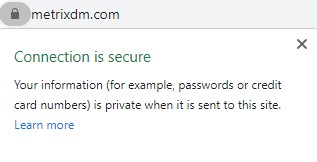
Google has stated that having an SSL security certificate will boost your search engine rankings. Every website that Metrix Digital hosts implement SSL security.
Duplicate content
Duplicate content is information that appears in more than one place on your website. Search engines will have trouble determining which page is the most relevant. The search engine may not index pages that it thinks are duplicates of each other. This could be a major problem if your primary service page is flagged as duplicate content by the search engine. We use Google’s Search Console to review a law firm’s website to check for duplicate content.
One example could be that you built a page to showcase your services in Dallas, Texas. You then decide to open up another law office in Austin, Texas. If you simply copy the Dallas page and replace any mention of Dallas with Austin, Google will probably say that this is duplicate content. You should be discouraged by making city pages and instead consult with an SEO expert on the best method to launch a page for your new office.
XML site maps
An XML site map is a file that tells the search engine every page that is listed on your site. It is like Google’s personal road map around your site. This is a file that all SEO specialists should generate for the client and upload to Google’s Search Console. This is an easy item to check off on your journey to SEO success!
Local SEO
Local SEO is a strategy that SEO experts implement to increase a law firm’s visibility in their hometown community. Any agency touting an SEO for lawyers package had better come prepared to talk about Google My Business and other local SEO tools.
If you practice in one specific region or city, you should include keywords about your practice area throughout your website. This is how Google knows to show your website to those searching in your local area.
Google My Business (GMB)
GMB is a free service offered by Google where you host information about your firm. This information is displayed on Google Maps and in Google search results when people type in keywords related to your law firm. GMB has sections to display your business address, website URL, office hours, office photos, telephone number, services, and products. You can even share posts about your firm or industry news.
GMB posts combine features of both blog posts and social media posts. While they aren’t as casual as social media posts, they aren’t as long and formal as a blog post. For our immigration lawyers, we may post updated news about federal immigration policy. We can also link back to the client’s website by referencing a blog post. Linking your local SEO strategy with your website is a great method to heighten your SEO return on investment!
Keeping up with your GMB profile and posts will help boost search traffic by displaying your business in the Google Maps pack. Google rewards those who regularly publish content. An optimized Google My Business profile should be on your list of local SEO initiatives.
This image shows search organic results for “divorce lawyer houston”. The GMB profiles show up in the Google Maps view and GMB listings. Users can click on the map icon to request directions to your business. This functionality demonstrates why your address must be correct and consistent across various legal directory websites.
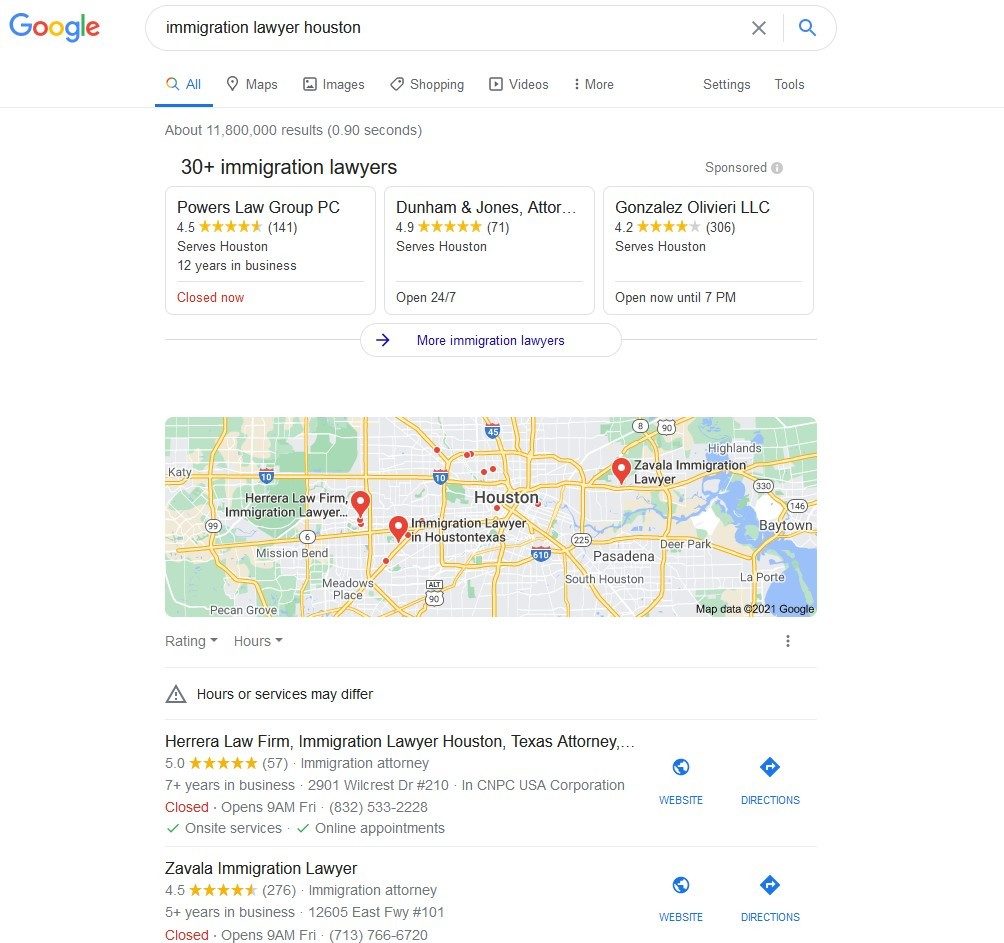
Off-page SEO
Off-page SEO works exactly how it sounds. It is any activity that you do off of your website that can help your rankings on the search engine. So what can I do to support my off-page SEO efforts?
- Build relationships in your industry because relationships will lead to backlinks
- Post to your social media page
- Have your brand mentioned online or in the news
Backlinks
Backlinks are the most popular form of off-page SEO. A backlink is a link to your website from someone else’s website. This could be a local news website, a business associate, a vendor, or anyone really.
Try to ensure your links are natural. Natural backlinks come from great content posted to your site. Someone will see your blog post and want to reference it on their website. This is a natural backlink. You didn’t have to pay someone or do anything to acquire it. Once you start posting blogs about your firm’s professional services, your site will gain search traffic. If your content is informative, people will start likely start linking to them.
If you are interviewed by a local news station, they should link to your website in the news article. It all starts with having a good working relationship with those in your community.
Now your site is not only showing up in search, but other people’s websites are promoting your firm too! All of these SEO strategies add up to more organic traffic.
Social media marketing and word of mouth advertising
An active social media page is another form of off-page SEO. Social media pages will spread the news about your brand. This in turn will drive organic traffic to your website. The best part about social media is it’s free! All you need to do is spend a couple of hours each week writing posts, sharing industry news, or posting videos. Some clients even host social media Q &As. This allows the firm to reach out into the community and better understand its customer base.
Here is an example from Lindsey Harris at LJH Law:
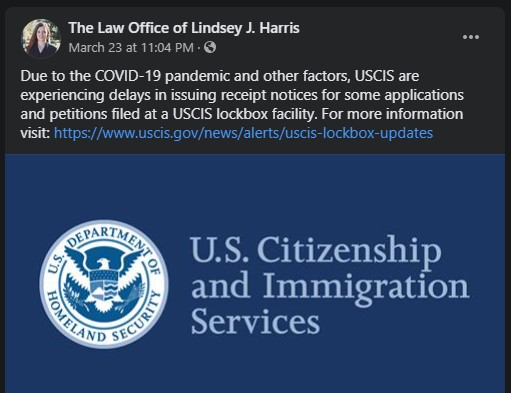
This post covers U.S. citizenship and Immigration services. This is a great way for the law firm to reach out to social media followers and share industry news. Perhaps this post is shared with other people looking for an immigration law firm? This simple action could result in a lead or even a paying client!
SEO For Law Firms Conclusion
Thank you for taking the time to read my post. I hope you found the topics covered useful. I think the key takeaways from this article are content, website design and functionality, and hard work!
SEO is not something that will change your law firm’s digital footprint overnight. It takes months of hard work to see results. But, SEO will provide lasting results for your online business. Once you start ranking your site for your target keywords, you will see your average monthly traffic increase. Hopefully, this will lead to more happy customers!
If you decide to take a stab at SEO, simply start writing and posting blogs. If you need technical SEO help or would like to schedule an SEO consultation, please fill out our contact us form! We would be honored to help you on your journey to SEO Success.
As always, make sure to track your Metrix!
-John
